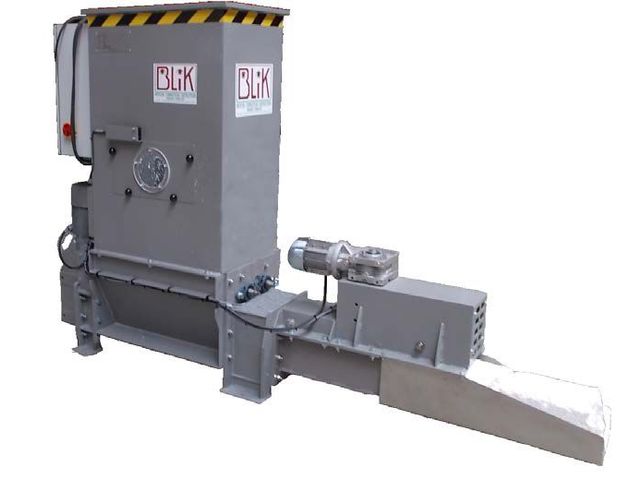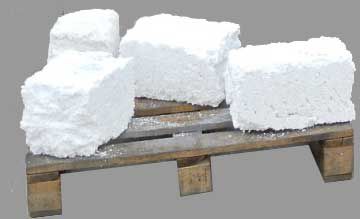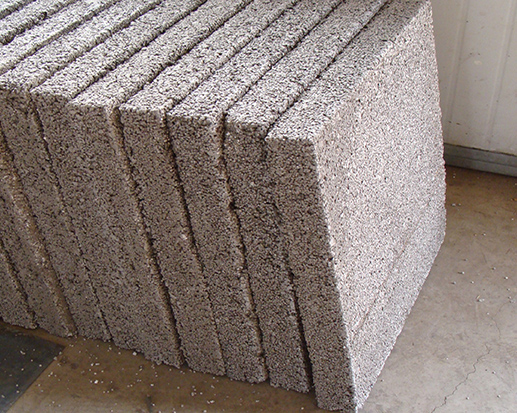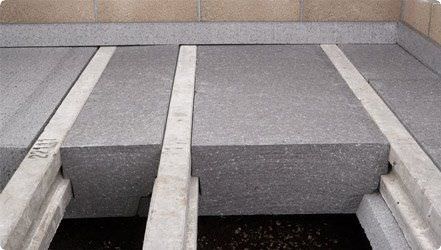CASE STUDY 1: Waste polystyrene reconsidered in the construction industry
Polystyrene (PS / EPS = expanded polystyrene) is good from a thermal and vapor technology standpoint, and its thermal insulation capacity does not diminish over time. It is a widely used polymerization plastic. When burned, toxic substances are produced. Polystyrene thermal insulation materials and other foamed plastics used for the safe transport of larger products are produced in large quantities. Since their it’s weight is extremely low and it’s volume is large, compared to other municipal waste, it can only be collected, transported and stored at an extremely high cost. Many people consider polystyrene-type materials (e.g. Nikecell, styrofoam, graphite polystyrene sheet) to be harmful to the environment. Because of the above-mentioned properties, waste management actors often stay away from polystyrene, its collection, transport and possibly further treatment. However, the Bonn-based Building Materials Environmental Protection Organization (ECO) classified polystyrene as an exceptionally environmentally friendly building material among thermal insulation materials, considering its entire life cycle. The recycling of used polystyrene foam now has many uses. Among other things, it can be used as a surfboard body, lightweight concrete, brick pore-forming material, heat-insulating plaster additives and without the presence of other pollutants, as a soil conditioner for agricultural purposes. Advertising signs, plastic flower pots and other useful objects can also be created from polystyrene that becomes redundant (Austrotherm 2019). PS plastic waste containing contaminants that are not suitable for recycling can be used as fuel, primarily in the cement industry.
It appears in significant volumes when purchasing larger electronic devices, furniture and other equipment. It is not possible to selectively collect separately, because the current selective waste collection methods do not even provide an opportunity for this, and the collection containers would fill up with it very quickly. The non-thermoplastic, cross-linked PS waste can also be used in shredded or ground form as a filler mostly in construction products (Csukat and Rácz 2002). Shredding and then compacting large polystyrene foams and turning them into denser polystyrene bricks is becoming more and more popular among the Hungarian waste management companies. This enables more space-saving storage and easier transport. The POLY 2000 compactor can be an excellent solution for efficient and quick compaction of EPS waste (Figure 3). In automatic mode, the equipment can shred and compress expanded polystyrene with a compression efficiency of 30:1 (Figure 4). The POLY 2000 device requires little space, operates with low consumption and has a user-friendly design (hulladekpres.hu 2018).

3. Figura Blik POLY 2000 polystyrene compactor (Source: industry-plaza.com)

4. Figura The already compressed polystyrene bricks (Source: directindustry.com)
Léka Estrich Kft., operating in Délegyháza (Hungary), primarily specializes in the production of special types of concrete and has gained extensive experience in their production. These include lightweight concrete, heat-insulating concrete, high-strength and wear-resistant concrete, as well as non-sparking concrete. Lightweight concrete is concrete with a high pore content, where three different methods are used to reduce bulk density (Balázs 1994). One form of lightweight concrete is polystyrene concrete (Figure 5), the price of which largely depends on the amount of material used. The additives of polystyrene concrete are polystyrene grains, whose density in the raw material is between 200 and 1000 kg/m3. The additive for polystyrene concrete is therefore expanded polystyrene pearls or waste-type expanded polystyrene foam packaging material. During the heat-treated swelling process, the pearls obtain their original grain size of approx. 40 times that, i.e. the diameter typically between 2-5 mm. Polystyrene beads enrich and lighten the concrete at the same time, thereby accumulating many beneficial properties (konnyu-beton.hu 2022).

5. Figura Polystyrene concrete slabs (Source: konnyu-beton.hu)
In general, lightweight concrete, including polystyrene concrete, is characterized by the following advantageous properties: low bulk density (up to 1200 kg/m3) and low particle density (up to 2000 kg/m3), pressure resistance, thermal insulation, mechanical and chemical resistance, fire resistance, frost resistance, and shape retention. Another advantage of polystyrene beads is that the boards are less susceptible to cracking, as the water absorption capacity of the additive is minimal. This also results in greater shrinkage (Fenyvesi 2012). Among its versatile areas of use, we mention only a few: step-resistant thermal insulation of attic floors, slab filling (Figure 6), floor heating, thermal insulation underlay for swimming pools, and thermal insulation layers for flat roofs (konnyu-beton.hu 2022). The use of polystyrene concrete has many advantages:

6. Figura Slab filling polystyrene with concrete (Source: konnyu-beton.hu)
- it improves the building structure’s thermal insulation capacity and heat attenuation,
- favorably influences the vapor diffusion function of the building structure
- it is not combustible (unlike the EPS sheets themselves), therefore the fire resistance of the building structure improves
- when used on a flat roof, it ensures the appropriate slope of the rainwater seal and a rigid, solid base
- its water absorption is low, so it is not a frost hazard (konnyu-beton.hu 2022).
Overall, due to both the beneficial properties of concrete slabs containing varying proportions of polystyrene beads and the tangible positives of recycling polystyrene in this way (lower transport and storage costs, less CO2 emissions), it should be encouraged to be used in the construction industry.

 Español
Español Turkish
Turkish български
български Magyar
Magyar Polski
Polski Português
Português